Responding To Negative Comments On Social Media
If your brand has a social media presence, and it should, it’s almost inevitable that you’ll run into some less-than-pleasant comments on your content. It’s safe to say that it’s one of the disadvantages of publishing free content on third-party platforms for general public consumption.
You have no control over the behavior and etiquette of others online (… yes, for those quick-to-post commenters who didn’t quite get the memo, there is such a thing as social media etiquette), and unfortunately this includes behavior which wouldn’t usually be attempted in-person.
If you’re a small business owner who wears multiple hats in the day-to-day operations of your business, being faced with these types of comments can easily leave you emotionally-charged. It’s understandable, and reasonable, that your automatic response might be to passionately defend your brand (particularly so if the commenter is lacking in common courtesy).
The bottom line: Don’t take the bait.
The stakes are high for brands that face negative social media comments and it’s always the negative comments that gain the most attention online. So ask yourself if your professional reputation and goodwill is worth a social media virtual war? Probably not.
And the fact is you won’t always be able to turn a negative situation or interaction around, sometimes it just… is what it is… and you might lose that customer as a result. But you can still manage how you respond on behalf of your business, address it as best as you can, and put your business in good standing with customers who come across the interaction. Ultimately, that means there’s good news to be found in any negative comment.
How can negative comments be advantageous to your brand?
It’s certainly not a business goal for any entrepreneur to have negative feedback, complaints or critique on their socials, but most customers would be reasonable enough to understand when a business does not have 100% positive feedback, 100% of the time. More than ever, most social media users know that the ratio of compliments-to-complaints is disproportionately skewed online, because people complain much more than they praise.
If handled correctly, you can use negative comments to position your brand in a more positive light by reassuring current and future customers that you have a co-operative spirit and dedication to actively seeking resolution. The act of responding in itself means that you care enough, which boosts your online reputation and credibility.
So, use those negative comments as opportunities to showcase your brand’s commitment to your customers.
Why should you respond to negative comments on social media?
Acknowledgement. It’s more powerful than you may realize.
At the end of the day, that’s ultimately what it boils down to: acknowledging the commenter’s experience. While some business owners are of the personal belief that giving any attention to negative comments is, in fact, a reward for socially unacceptable behavior, that’s not the case at all – as you never have to tolerate any false representation or abuse online. You should absolutely be firm and unwavering in clearing up any misinformation about your brand.
As with everything in life, there are always exceptions to the rules. If you’re dealing with a commenter who has simply gone too far or perhaps you’re dealing with an internet troll, then that’s perfectly acceptable to ignore.
Take a look at how the social media team at Westpac, an Australian bank, have identified a commenter as a troll who is repeatedly spamming the same comment on each new Facebook post.
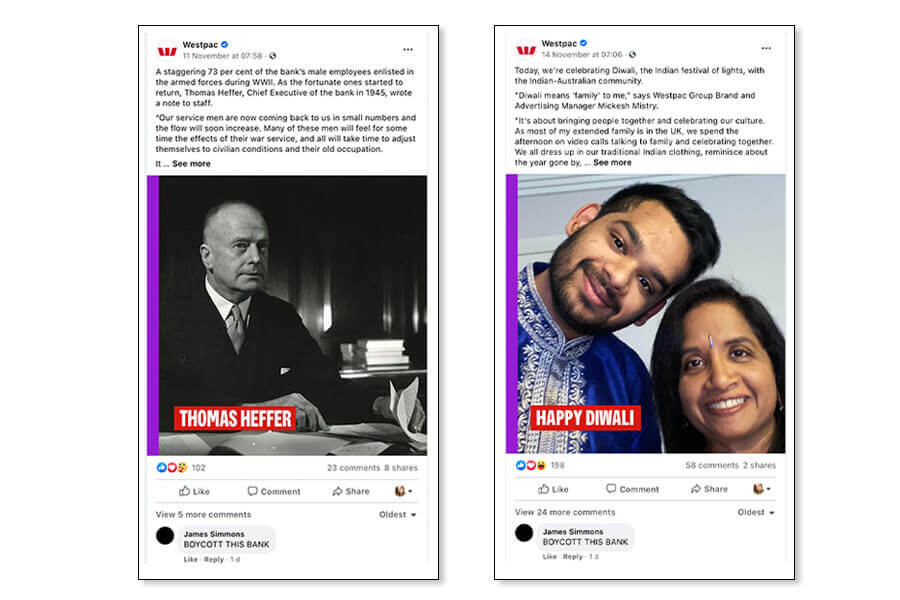
They simply do not engage, until the commenter stops at some point. We’ll address this later on, and although it is the correct approach to ignore in this case, there is something more they could do about this.
However, not every negative commenter is automatically an internet troll. Trolls are the dark side of engaging with the public on social media platforms. But if you do encounter a troll, then that’s completely different to interacting with a disgruntled customer. While a troll is there to stir up trouble and does not have an authentic complaint, a dissatisfied customer does have a legitimate complaint.
Simply because you do not like or agree with a comment, does not mean it is not a complaint that must be dealt with swiftly and effectively despite your feelings or personal opinion on the matter.
Poor customer service, damaged products, or incorrect orders, these are some of the common reasons for negative online comments. And while you might not be able to resolve the problem immediately, simply engaging in a timely fashion will provide the acknowledgment they seek that their concern is being attended to in due course.
Of course, when you’ve intentionally curated valuable content – presumably costing you a combination of time and money – then it can be painful to see an angry comment splashed on it. And, usually, a commenter will comment on your most recent post which is completely unrelated to their complaint and that certainly feels like it overshadows your post.

As the above commenter so aptly demonstrates, they do not care about the restaurateur, but the posting in itself has triggered them to complain about being unable to access their money.
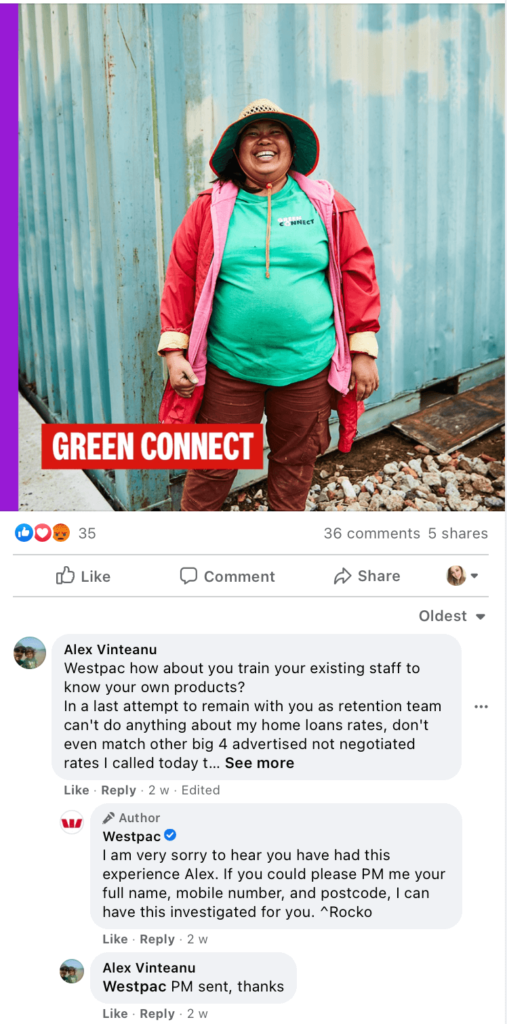
Here’s another example of Westpac’s post on their latest “Green Connect” initiative, showcasing their Foundation’s brand new recipients for a community project – only to receive negative comments on an entirely unrelated issue.
The thing is, Westpac, Commonwealth Bank and other major corporations have trained teams of people ready to respond to commenters like this – it’s their job. But if you’re a startup or small business owner, it’s harder to tackle these complex online interactions when you’re so invested in the content you’ve put out and now somebody is venting out their frustrations on it.
You might even have a feedback form on your website, precisely for this purpose, and despite that your social media is most likely to still be hit with complaints. That’s because brands are expected to respond to their socials either in real-time or within a matter of hours, with a reported 40% of customers expecting a response within the first hour.
And social media being so easily accessible, people take it as licence to say anything to anyone. Sending off a form on a website is not not nearly as satisfying as publicly calling out a brand, with someone going so far as to spending $1,000 to promote a Tweet to complain about a company.
It’s unavoidable. So nip it in the bud and address it head on, politely and effectively.
Is just deleting negative comments a bad idea?
Unequivocally, yes.
It’s clear that complaints online are impossible to evade in today’s world. The hardest part about it is taking the high ground. But it will serve you well to remember that even when the person posting becomes abusive, there’s no world in which it will be a good look for your brand to be abusive back.
Again, there’s always exceptions and so judgment calls have to be made. Personal attacks, discriminatory or inflammatory statements, and threats of any kind are a no-go. Engaging with this type of commenter will not place you in good standing, so safely ignore.
Well, ignore but also report it. The functionality to do so is there for a reason! Social media platforms each have their own terms and conditions of use, and the ability to very easily report users who violate them. Most platforms have become increasingly strict and take violations seriously as they have started to crack down on spreading misinformation and online harassment. There’s a number of reasons for reporting a post, just select the one that best describes your complaint.
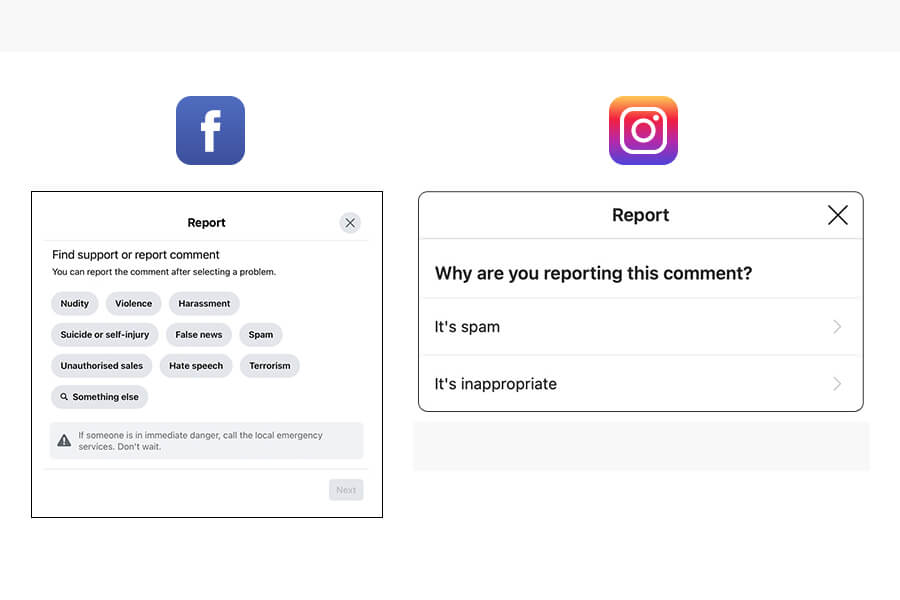 Before reporting a comment on Facebook or Instagram, take a screenshot if a comment falls into this category so you can document it for any legal issues that may arise.
Before reporting a comment on Facebook or Instagram, take a screenshot if a comment falls into this category so you can document it for any legal issues that may arise.
If the comment falls within the platform guidelines, but is unfounded and factually incorrect, firmly but courteously set the record straight and then move on – even if the commenter continues to respond thereafter.
Here’s a perfect example of American airline, JetBlue’s response to a disconcerting false claim on the safety of an aircraft.
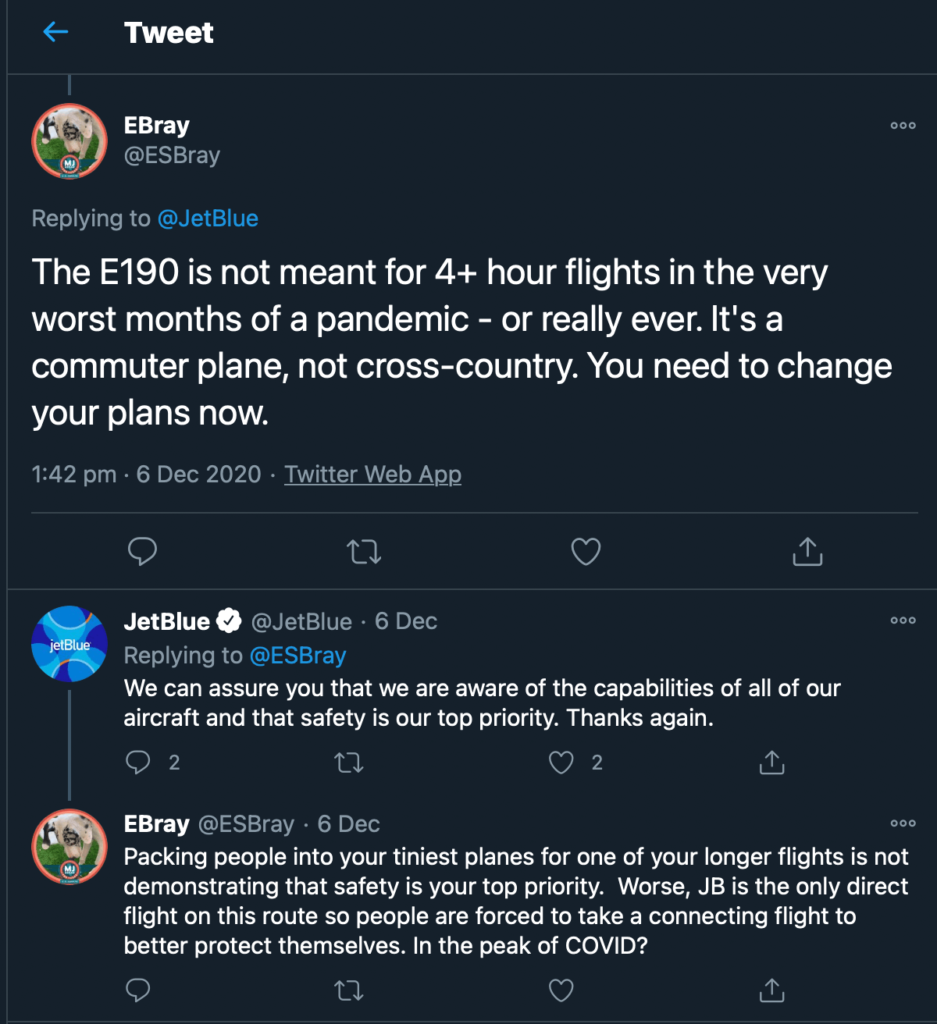
What about responding to smaller complaints or critique?
Ignore them? Just apologize? Post a generic response?
We’ve established that it’s best not to avoid or ignore comments, to protect your brand’s online reputation. In many cases, by ignoring the commenter, even on small complaints, it simply confirms what they are claiming. There’s immense irony in seeing a comment that reads, “Worst customer service ever! Avoid this business because I’ve been trying for 2 days to get a response!”… with no reply.
Appropriate responses to these comments are very dependent on scenario and context. Analyze the commenters problem and tone in which the complaint is written, and mirror a similar voice response based on your best judgment. Make the call if the person is someone who might respond well to light-hearted response or even humor, or if your audience at large would appreciate a humorous comment. If in doubt, of course, always go the serious route.
Wendy’s has established themselves as an exception to all the rules, living every social media manager’s dream as they are seemingly given free reign. Their account has witty comebacks and often quite snarky remarks, and it has become part of their branding and worked out for them, along with a few other brands.
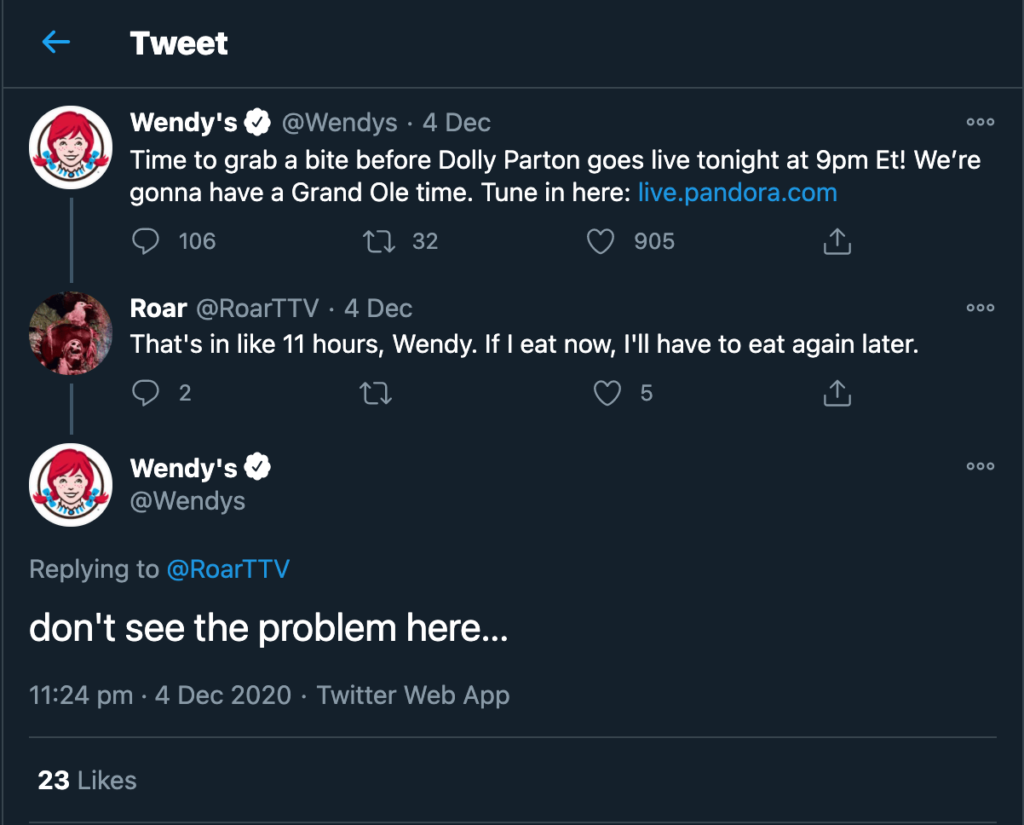
However, the numbers always tell the full story. A survey found that 72% of people appreciate funny brands, but 88% of people find it annoying when brands tease their commenters and a further quarter of them will boycott a brand as a result. Looking at the stats, the majority of customers are inclined to spend their money on brands that are honest (86%), helpful (78%) and friendly (83%). Turns out, customers want brands to use their social media accounts as a customer care channel too.
Is it better to respond privately or publicly?
Private replying is best, as you are able to go in-depth without continuing or escalating the issue in public view. But you’ve got to be strategic about it, as it won’t help public perception if the resolution is done entirely in private. You should publicly apologize for their experience and inform them you’ve sent a private message as you’d like to resolve their issue. These private replies are either called a “DM” (direct message) or “PM” (private message).
For smaller issues, or questions, you can reply publicly to show good customer support and willingness to take feedback. These are for easy to resolve, non-escalating problems. Even if somewhat accusatory in tone, they are usually just struggling to find the information they are looking for. So answering these are a great opportunity to reduce confusion, stay connected with your audience, and make your customer service look good.
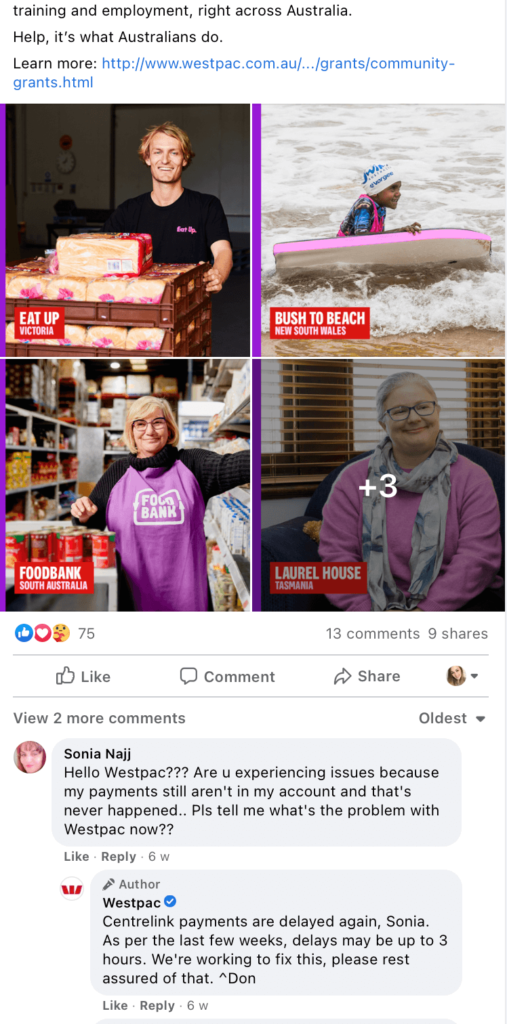
To repeat, unfounded allegations are certainly worthy of a defence. It’s important to address them head on in a firm and matter of fact tone – just as JetBlue did. Also, addressing a commenter does not mean you have to tolerate borderline behavior, point them towards the community guidelines if necessary.
Is it important to establish community guidelines?
Yes. It’s the most efficient and effective way to state acceptable and unacceptable standards and serves as a reference to point offenders to. Cultivate the atmosphere and environment in which you would like community members to communicate with you and each other.
Creating a list of guidelines for interacting with your published content means that you can refer them to your guidelines as reasoning for why they are in violation. While you could state in your community policy that comments deemed inappropriate will be deleted, it’s not advisable to do so. By deleting comments, you are more than likely to incentivize the commenter even more to continue posting.
Luckily, it is possible to “hide” comments on some platforms. That means that the comment will only be visible to the commenter and their friend list, but nobody else. And the commenter is not notified of this, so they won’t be any the wiser that they have essentially been muted.
On Facebook, just select the three dots next to the comment, and the options will come up.

Better yet, you can be proactive and automatically hide comments with certain words or phrases on Instagram by using “Comment Filtering”.
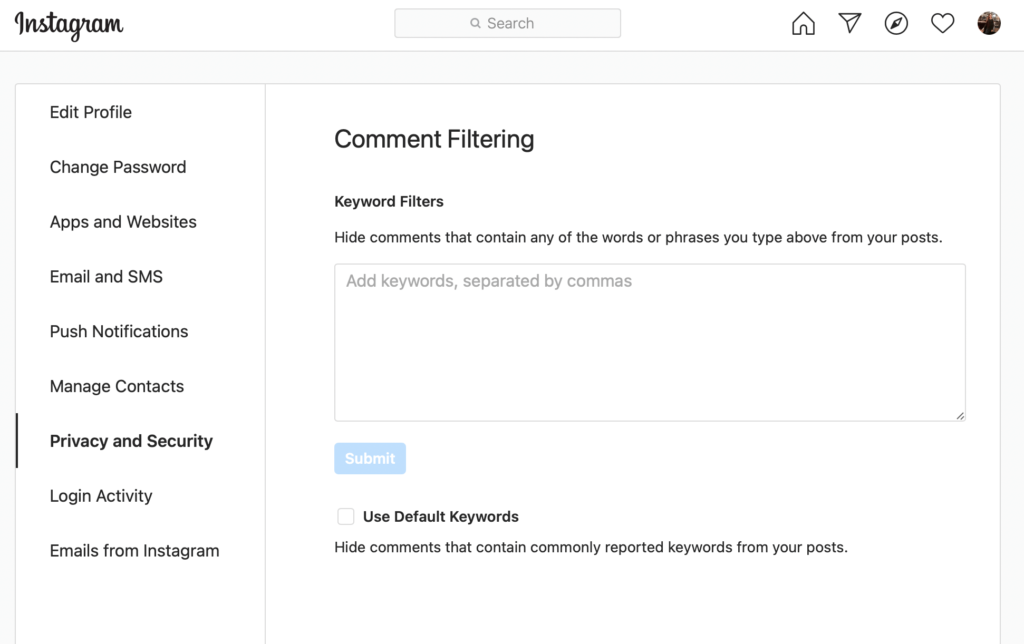
Building a supportive community means that others will take notice of your reply. Most likely, your community will want to jump and make the trolls feel unwelcome. Being responsible, and taking the high road, means that your community will respect and support you.
What to do about untagged complaints on social media?
Traditionally, you’d wait for a customer to contact you with their complaint. But you might not even be directly tagged or mentioned in a negative comment or post, so it’s good practice to do a periodical online search for your business and respond to those complaints – or even compliments. This truly shows, even more so, that you are open to engage in constructive dialogue and resolve issues online.
Bank of Ireland is an excellent example of responding to all feedback – whatever it may be – in which they are mentioned.

If the comments are positive or informative, all the better and more reason to respond! Social media management tools are designed to help you do so, but Google Alerts also helps you monitor comments to stay on top of your online reputation. Track keywords of your preference and set how you’d like to be notified for things you may not be aware of across channels.
Every commentator and scenario is unique, so it’s best to take a personalized approach. Social media is a two-way form of communication, and not just somewhere to post your promotional materials and content. Driving engagement and remaining part of the conversation is what works best.
If you’re finding it too challenging or struggling to stay on top of it, outsource the task to a Virtual Assistant and free up your time for more productive activities.
As they say, lead by example – it’s up to you to set the tone for your online community. And don’t forget to consider the fact that perhaps something does need to be changed if you are getting the same problems in your comment section. Address the problem, and then you won’t have to deal with negative comments about it. Really use the opportunity to get user feedback and listen to your audience.

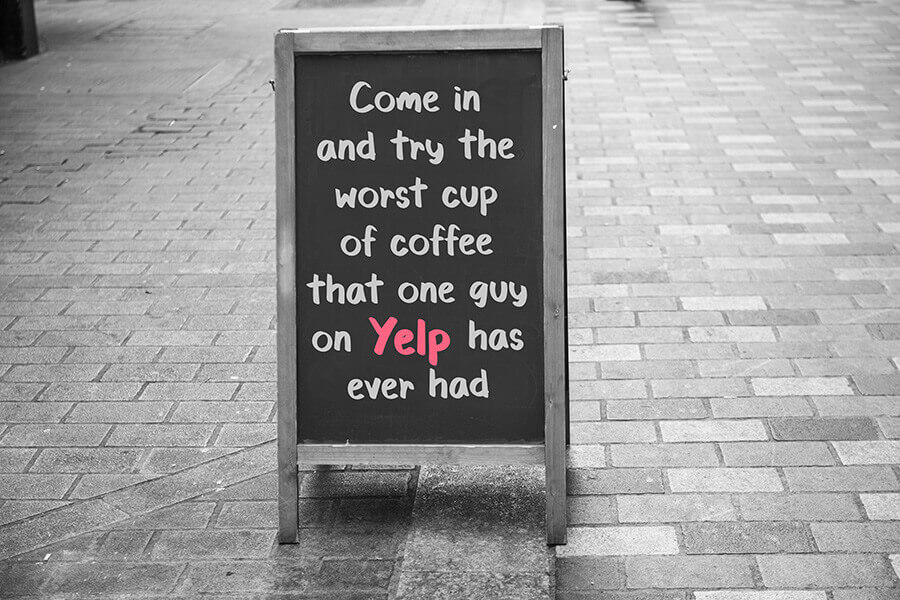

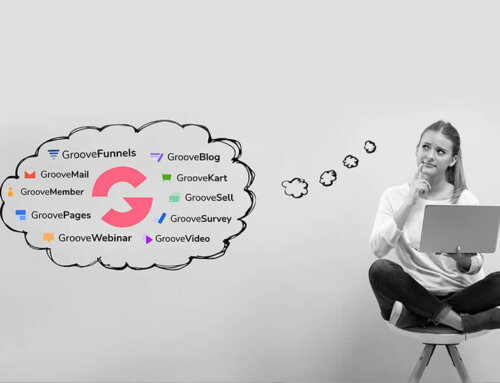

Leave A Comment